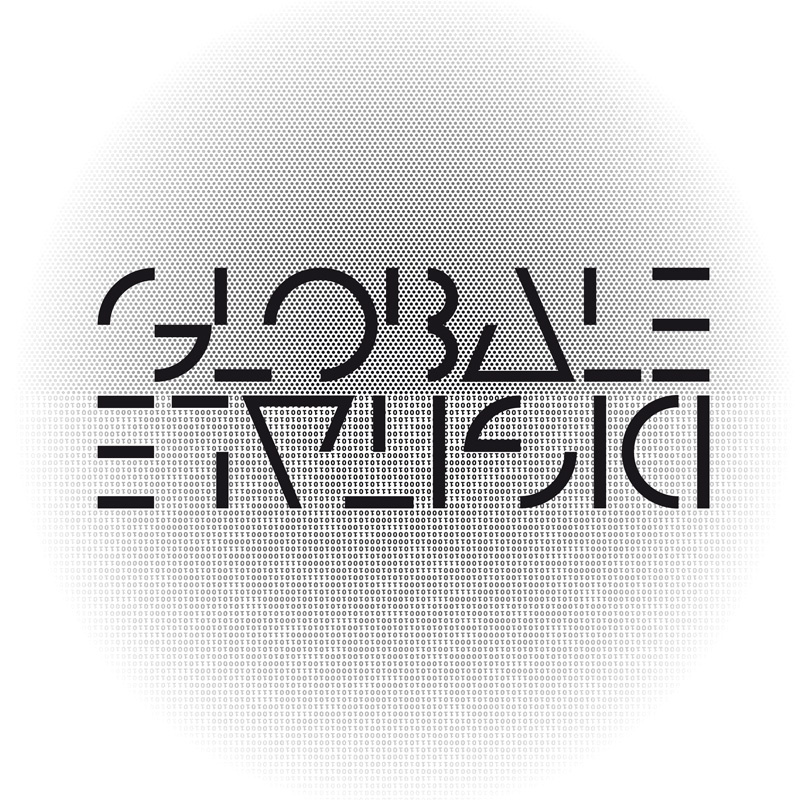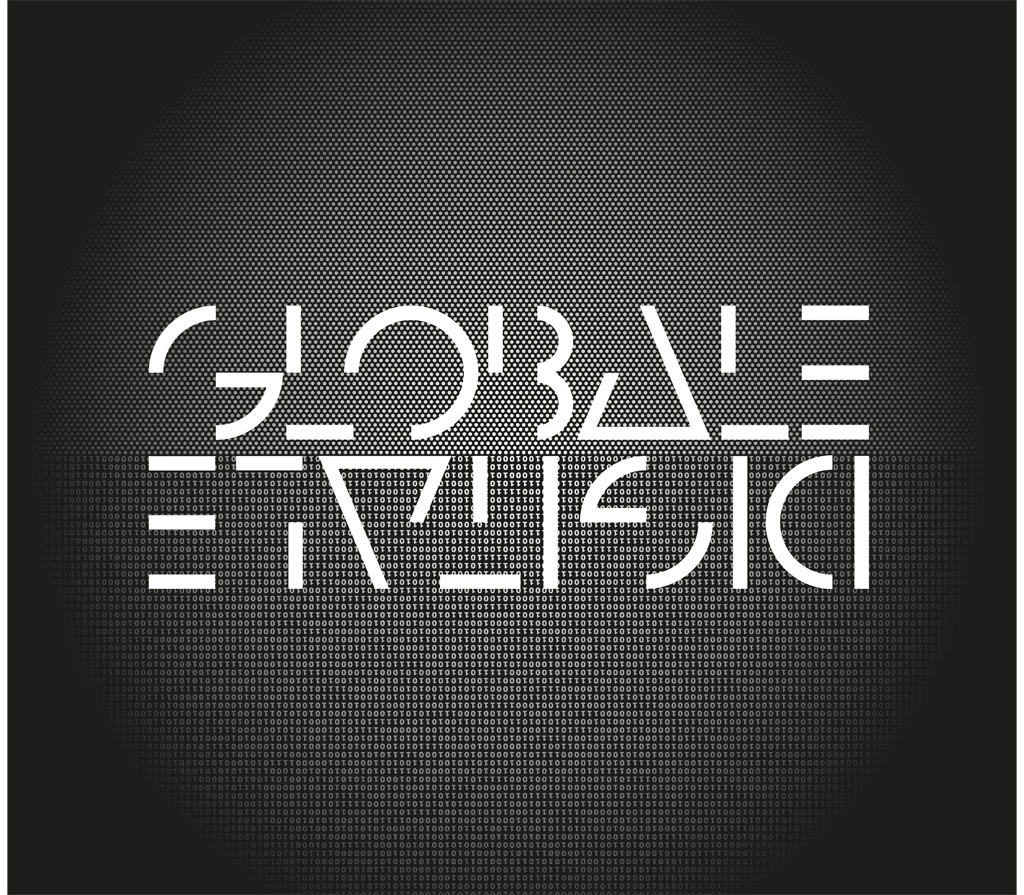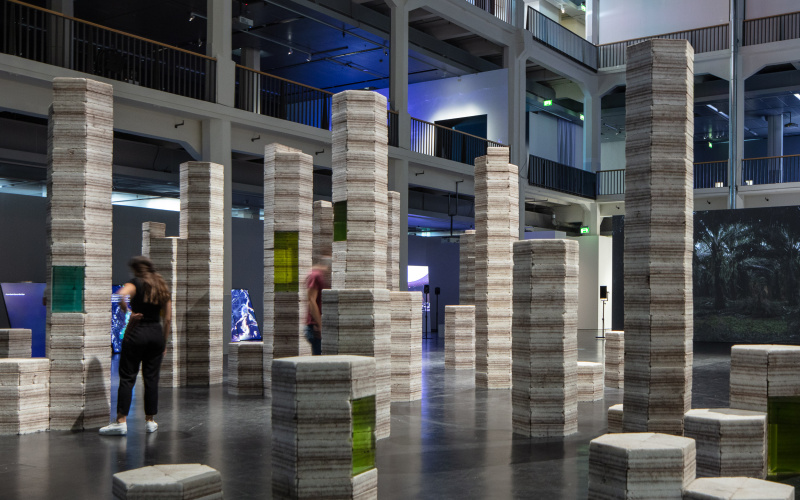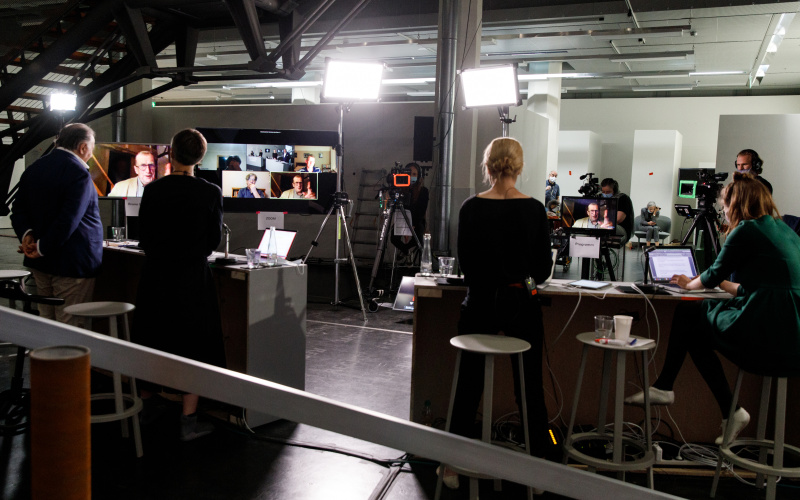300 Years Karlsruhe – 300 Days GLOBALE
Globalization and the digital revolution have transformed the world. With exhibitions, concerts, performances and symposia, the polyphone, multipolar event GLOBALE – both laboratory and academy – presents the decisive artistic, social, and scientific tendencies of the twenty-first century.
Art and Evolution
Human eyes and hands were created by nature and evolution. For millennia, human beings have produced art with their hands and with their eyes – with their natural tools. Over the ages, painters, from Leonardo da Vinci and Joseph Wright of Derby to the Impressionists, have portrayed the natural light of the sun with paint. At the beginning of the nineteenth century, painters began setting up their easels en plein air, in order to depict the landscape in natural light. Outdoor painting represented the triumph of the natural triad of light, air, and color, but the artist also required manufactured, artificial paints in transportable tubes and portable easels, in other words, technical products.
Like the hand, the air is a product of evolution. The air-processing organ, the lung, is the evolutionary response to the oxygen in the atmosphere, which is the result of photosynthetic processes developing over the course of billions of years. The animate creatures dwelling on the earth’s surface possess lungs, which live on the oxygen in the atmosphere that envelops the earth.
The eye, the light-processing sense organ, is evolution’s limited answer to the light-emitting sun. Nuclear fusion in the sun generates massive radiation energy, which spreads in wave form in an electromagnetic field, and which may at the same time comprise tiny particles of energy (photons, from the Gr. phon ›light‹). Whereas solar radiation is partially visible, microwaves, roentgen radiation (X-radiation), and long radio waves are invisible. The human eye is only sensitive to a limited waveband: namely, to the spectrum between 380 nm (violet) and 780 nm (red) wavelengths, the phenomenon we refer to as light. In a series of experiments carried out on spark discharges between 1886 and 1887, Heinrich Hertz proved that light consists of electromagnetic waves.
Waves with frequencies in the range 20 Hz to 30,000 Hz are referred to as sound waves. The ear is the evolutionary answer to the existence of sound waves, as is the eye to the existence of light. In the case of natural sense organs, sight, smell, taste, touch, and hearing, the human being operates within a limited frequency range and in a limited sphere. In his trilogy Spheres (1998–2004) Peter Sloterdijk explores these differentiated spheres of living creatures and modes of living. The human being is bracketed between two »critical zones« (E. Codman, 1934): below is the terrestrial zone, from the tree canopy down to the groundwater body, where the most dangerous and degenerative transformations in substance conversion processes occur (Anthropocene); above is the aerologic zone, the stratosphere, beyond normal signal space, which is a secret domain of the military.
Art and Infosphere
Although the earth has been surrounded by an electromagnetic field ever since its formation, and the sun has radiated electromagnetic waves, it was work on the magnetism of the earth (W. Gilbert, 1600) and the experiments of Heinrich Hertz and others proving the existence of electromagnetic waves a mere 130 years ago that resulted in the telematic culture (tele, Gr. ›remote‹) of telegraphy, telephony, television, radio, and Internet.
The eyes, the ears, the hands, and the lung are evolution’s response to natural conditions including sunlight, sound waves, and atmosphere. Painting and music – the art forms of the hand and the mouth for the eye and the ear – are the human being’s first responses to evolution that utilize these two natural sense organs, brought forth by evolution itself, and manufactured instruments contrived by human beings within the limited range of frequencies or wavelengths visibly or aurally accessible to humans. New electronic and digital art forms, such as film, video, and computers that use the extended spectrum of electromagnetic waves conquered by humans 130 years ago, began to appear around the mid-twentieth century.
Indeed, why should this new field remain the exclusive preserve of the sciences?
The question as to why nature has not equipped us with the kind of organs capable of perceiving a larger spectrum of electromagnetic waves continues to be one of the enigmas of evolution. For example, terahertz radiation (between infrared and microwaves) is invisible to the human eye, although it serves a visualization function in full-body scanners for security control at airports. Thus humans were obliged to construct artificial and technical organs themselves, such as radio, telephone, television, radar, satellite, global positioning systems, and Smartphones, in order to extend the spectrum of electromagnetic waves accessible to them. Hence, after the atmosphere, an increasingly expanding and dense infosphere began to emerge; a canopy of radio waves enveloping the earth for the wireless transmission of language, images, and other data. It is this worldwide network of wireless radio connections spanning the earth that ensures the global exchange of data – from the stock market to air traffic – and the organization of goods and passenger transportation. We thus live in a new sphere, the so-called infosphere, and the infosphere has meanwhile become as necessary for the lives of the over seven billion human beings inhabiting the earth as the atmosphere is.
Art and Exo-Evolution
With the scientific revolution of the modern age and the subsequent industrial revolution, for which the equation »Machinery, Materials, and Men« (F. L. Wright, 1930) holds, humankind has created an entire universe of tools, from the microscope to the railway. These tools have both facilitated humans’ reach beyond the constraints of their natural organs, and enabled them to transform their perception of the world to extend this reach even into hitherto invisible zones.
Once members of the genus Homo began to stand fully upright, the hand became the primary tool. With their hands, human beings created new tools, meta-tools with which they, in turn, were able to create yet more tools. With the advent of these tools humankind stepped out of natural evolution, and became »the first liberated member of creation« (J. G. Herder, 1791). Hence, handicrafts developed from the hand, and technical culture from handicrafts. With the arrival of the mechanical revolution natural functions and organs were increasingly »outsourced« and externalized: the hand to the hammer, the foot to the wheel, the eye to the microscope or telescope, the voice to the microphone, and so on. Since the digital revolution, an increasing range of mental processes have also been outsourced, for example, neuronal networks in calculating machines, thought processes in algorithms.
By means of machines and media, humans create artificial organs which compensate for the shortcomings of their natural organs: from eyeglasses as exo-eye, from hearing aid as exo-ear through to exo-skeleton, which helps the disabled to move, we are witnessing the emergence of an ever greater number of exo-organs – the exteriorization of natural organs. In addition, humans also create new technical organs or tools. Exteriorization has now gone so far as to search for life outside the earth (exo-biology, exo-planets). Ultimately, the aim is to exteriorize life itself, for example, the exteriorization of human reproduction, life artificially and technically manufactured in the laboratory (e.g., exo-pregnancy).
The sum of all tools, machines, and media is what constitutes exo-evolution: a humanmade and controlled exo-evolution of artificial organs or tools. The contours of this development we are only just vaguely beginning to perceive since their timescale is not even the blink of an eye compared to the billions of years of natural evolution.
Renaissance 2.0
In the modern age, natural and engineering sciences were added to the classic systems for explaining and transforming the world, such as religion, politics, philosophy, and art. By means of experimental systems and the noetic turn – a shift from language to tool-based culture – science had no qualms about increasing its scope of enquiry to atoms and molecules in order to change the world. Art has limited itself to the constraints of natural perception for far too long. While science has penetrated into hitherto invisible zones with the aid of apparatuses and devices, art has remained on the surface of the visible spectrum. Today, art and science are drawing closer together for they both use the same new technologies. Artists’ studios now look the same as science laboratories. The tools and the forms of knowledge in science and art are engaged in dialog, from the visual research of Op Art through to art-based research. This new interlinking of art and science is very reminiscent of the seventeenth century, the Siècle d’or, and the Renaissance. Hence, we may well refer to a Renaissance 2.0, which includes Arab and Asian sources.
Contemporary performative, media, digital, and action-oriented art has not the slightest intention of being excluded from the transformation of the world; it seeks to contribute to its construction, and to replace representation with reality. Such art opens up new perspectives and options for the digital society of the twenty-first century, for which the equation »media, data, and men« holds. Museums, print media, and the art market, are accomplices in denying this art to the public, although it exists all over the world. It was for this reason that GLOBALE was initiated.
Art and Digital Revolution
In the twentieth century, art responded to the stress of the massive flood of stimuli caused by big data environments with a program of reduction: silence in music, monochromatic paintings. In the twenty-first century artists abandoned subjective expression, and began processing, with scientific methods, the noise of data and the generator programs of algorithms into acoustic and visual works of art with outstandingly sublime aesthetics. They rendered visible to us the black boxes of the infosphere, and they opened doors in places where apparently none existed. They built new cathedrals of sound and light. The digital revolution changes the notion of art by liberating its components. With the emergence of photography, painters forfeited their monopoly on the production of images; and, similarly, with the introduction of digital technology, artists are obliged to yield their monopoly on creativity. Not only is everybody an artist, but, through the social media, everyone has become a transmitter and a receiver. In this way, new political forms of action emerge, which empower and support the emancipation of the individual and foster civic participation. They warn against the negative effects of globalization and digitalization, namely, that the liberated member of nature is now rapidly becoming the hostage of a security junta: the danger of pollution holds good for the infosphere no less than it does for the atmosphere. Freedom for the infosphere is law, and an 11th Biblical commandment is now called for: »Thou shalt not covet thy neighbor’s data.«
Hence, GLOBALE begins with a tribunal: with a trial (F. Kafka, 1915) in which the twentieth century is indicted for its crimes against humans, animals, and nature.
Text: Peter Weibel
ZKM insert in: KUNSTZEITUNG, ed. Lindinger + Schmid, May 2015, No. 255




